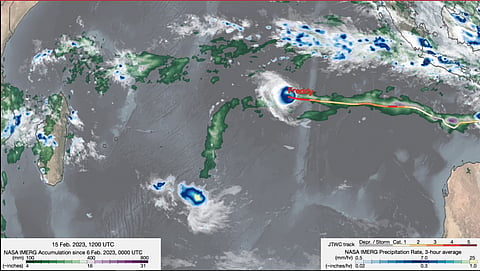

Cyclone Freddy dissipated over Malawi March 15, 2023 after a record-breaking 37-day stint over the southern Indian Ocean and Africa.
In this period, the storm broke at least six meteorological world records and 10 records for the south Indian Ocean, according to Vineet Kumar Singh, research scientist at the Typhoon Research Center, Jeju National University in South Korea.
Singh’s analysis was based on data from the Joint Typhoon Warning Centre of the United States Navy, Bureau of Meteorology of Australia and Meteo-France.
At 37 days, Freddy is the longest lived tropical cyclone ever recorded in any of Earth’s oceans and has broken the record of 31 days set by Hurricane John in 1994.
How Cyclone Freddy travelled
Source: NASA, Vineet Kumar Singh
Tropical cyclones are named as cyclones, hurricanes or typhoons based on the ocean basin where they form but are essentially the same type of storm system that forms over warm ocean waters and is fed by moisture in the form of swirling winds.
Freddy also broke the record for the highest accumulated cyclone energy (ACE) at 87.01 units, breaking the record of 85.27 units by Hurricane Ioke in 2006.
ACE is the total wind energy generated by a tropical cyclone throughout its lifetime and is calculated as the square of peak wind speed, observed, calculated and added every six hours.
Cyclone Freddy’s ACE is as much as the total ACE of all hurricanes in an average North Atlantic hurricane season, according to a press release by the World Meteorological Organization (WMO).
Records set by Cyclone Freddy
Source: JTWC, NOAA, BOM, Meteo-France and Vineet Kumar Singh
Apart from this, Cyclone Freddy is the first tropical cyclone ever to experience seven phases of rapid intensification (RI) over its lifetime. RI is when a tropical cyclone gains wind speeds of more than 55 kilometres per hour in a period of 24 hours.
The previous record was four RI phases jointly held by Hurricane John (1994), Hurricane Emily (2005) and Hurricane Norman (2018).
It made yet another world record when it held peak wind speeds of 65 km / hr for 22 days.
After travelling for more than 7,000 km from the northern coast of Australia to the south eastern coast of Madagascar over a period of 15 days, the cyclone played a unique bouncing back and forth rally between the Madagascar and Mozambique coasts and followed a zigzag pattern over Mozambique, Zimbabwe, Zambia and Malawi.
This occurred over a period of 22 days from February 21 to March 15, during which the storm wreaked havoc in Madagascar, Mozambique and Malawi, with torrents of rain and swift winds in some parts of Zambia and Zimbabwe.
Track of Cyclone Freddy
Source: Joint Typhoon Warning Centre and Vineet Kumar Singh
The cyclone made landfall thrice — once in Madagascar and twice in Mozambique. It made its first landfall along the southeastern coast of Madagascar on February 21, following a path similar to cyclones Batsirai and Emnati in February 2022 that devastated the island country.
It then fell into the Mozambique Channel, intensifying slightly and made a second landfall along the southeastern Mozambique coast on February 24. It then zigzagged over Mozambique and Zimbabwe for a few days, causing rainfall and then was pushed back towards the Mozambique Channel by a high pressure area.
There it intensified again and moved towards Madagascar’s southwestern coast, threatening a third landfall which did not happen. But there was a significant amount of rainfall on March 5 and March 6, 2023.
Then cyclone Freddy abruptly looped and started moving back towards the northeastern Mozambique coast. Here it finally made landfall on March 11, making its way to Malawi where it caused significant flooding.
“The ongoing rainfall (in Mozambique) will exacerbate flooding from Freddy’s first passage and from heavy seasonal rains, which mean that rivers are full and the ground is sodden,” said WMO in a press release.
“Southern Mozambique received more than a year’s worth of rainfall in the past month and Madagascar got three times the monthly average in the space of a week,” it added.
Around 140 people have died due to flooding, landslides and other rain- and wind-related incidents in Madagascar (17), Mozambique (10) and Malawi (111) over the 22 days that Cyclone Freddy was active in the region, according to the United Nations Office for the Coordination of Humanitarian Affairs.
It also displaced 22,000 people in Mozambique and 19,000 people in Malawi. Almost 300,000 people were affected by the cyclonic wind speeds and rain in Madagascar. In Mozambique, some 1.75 million people have been affected, the country’s national disaster management agency INGD estimated.
Cyclone Freddy covered a total distance of 8,500 km during its lifetime and reached a peak wind speed of 260 km / hr on February 19, according to Singh.
The records are unofficial as of now and have to be validated by WMO, the process for which has started.
“The WMO Weather and Climate Extremes Archive are currently assembling a blue-ribbon international committee of scientists. Once the tropical cyclone has dissipated, these experts will begin a detailed examination of the raw data to determine if Freddy has indeed established a record as the longest-duration tropical cyclone,” said Randall Cerveny, WMO Weather and Climate Extremes rapporteur, in a press release.
“One question that we will be addressing is the fact that throughout its long lifetime, the storm has periodically weakened below the tropical storm status. We will obviously need to address if that is a concern in our evaluation,” he added.